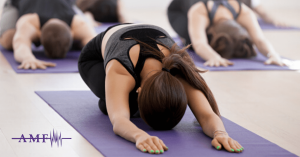Reduce Migraine Symptoms with Yoga or Physical Therapy
By John M. de Castro, Ph.D.
“Overall, yoga improved the cardiac autonomic balance. Disturbances in the autonomic nervous system and in the regulation of the circulatory system are associated with migraines. If balance is restored, the likelihood of a migraine is reduced.” – Debra Sullivan
Migraine headaches are a torment far beyond the suffering of a common headache. It is an intense throbbing pain usually unilateral, focused on only one side of the head and lasts from 4 hours to 3 days. They are actually a collection of neurological symptoms. Migraines often include: visual disturbances, nausea, vomiting, dizziness, extreme sensitivity to sound, light, touch and smell, and tingling or numbness in the extremities or face. Migraines are the 8th most disabling illness in the world. While most sufferers experience attacks once or twice a month, about 4% have chronic daily headaches. Migraines are very disruptive to the sufferer’s personal and work lives as most people are unable to work or function normally when experiencing a migraine.
There is no known cure for migraine headaches. Treatments are targeted at managing the symptoms. Prescription and over-the-counter pain relievers are frequently used. There are a number of drug and drug combinations that appear to reduce the frequency of migraine attacks. These vary in effectiveness but unfortunately can have troubling side effects and some are addictive. Behaviorally, relaxation, exercise, and sleep appear to help lower the frequency of migraines. Mindfulness practices have been shown to reduce stress and improve relaxation. So, they may be useful in preventing migraines. Indeed, it has been shown that mindfulness practice can reduce headache pain. Yoga is both a mindfulness practice and an exercise. It has also been shown to help reduce pain. Hence, it may be effective in treating migraines.
In today’s Research News article “Study of Additive Effect of Yoga and Physical Therapies to Standard Pharmacologic Treatment in Migraine.” (See summary below or view the full text of the study at: https://www.ncbi.nlm.nih.gov/pmc/articles/PMC7846311/ ) Mehta and colleagues recruited adult patients diagnosed with migraine headaches and randomly assigned them to either standard care or to receive standard care plus either yoga training or physical therapy. They were trained and then practiced at home daily for 3 months. Before training, at 1 and 2-months during training, and after training they were measured for headache pain and headache frequency and headache impact.
They found that all three groups had significant reductions in migraine frequency, severity (pain), and impact on life. Both yoga and physical therapy reduced frequency and impact on life to a significantly greater extent than standard care.
These findings suggest that either yoga or physical therapy when added to standard care for migraine headache produces significant additional improvements in the symptoms of migraine headaches. The fact that yoga and physical therapy did not differ in effectiveness suggests that the physical exercise provided by yoga is the reason for yoga’s effectiveness. These findings suggest that yoga practice or physical therapy should be added to the standard care for patients with Migraine headaches.
So, reduce migraine symptoms with yoga or physical therapy.
“Yoga’s postures, deep breathing and meditation . . . could be very helpful in both treating migraine and fighting the disability associated with migraine.” – American Migraine Foundation
CMCS – Center for Mindfulness and Contemplative Studies
This and other Contemplative Studies posts are also available on Google+ https://plus.google.com/106784388191201299496/posts and on Twitter @MindfulResearch
Study Summary
Mehta, J. N., Parikh, S., Desai, S. D., Solanki, R. C., & G. Pathak, A. (2021). Study of Additive Effect of Yoga and Physical Therapies to Standard Pharmacologic Treatment in Migraine. Journal of Neurosciences in Rural Practice, 12(1), 60–66. https://doi.org/10.1055/s-0040-1718842
Abstract
Objective We aimed to evaluate and compare the effectiveness of physical and yoga therapies as an adjuvant therapy along with standard pharmacologic treatment in patients with migraine.
Materials and Methods A total of 61 consenting patients diagnosed to have migraine were randomized into three groups to receive either standard treatment alone, physical therapy along with standard treatment, or yoga therapy along with standard treatment. The respective adjuvant intervention was taught to the respective group of patients and they were advised to perform it daily for 3 months with weekly telephonic reminders and review of their activity logs. Outcome measures assessed were headache frequency, Short-Form McGill Pain Questionnaire (SF-MPQ), and Headache Impact Test-6 (HIT-6) at recruitment and once every month for 3 months.
Statistical Analysis Statistical analysis of the study was done by using Stata 14.1 software. All the descriptive statistics, paired t -test was used to compare the difference between pre and postintervention values of headache frequency, SF-MPQ, and HIT-6 score within all the three groups. Analysis of variance test and post hoc test were used to compare the differences between all groups for outcome measures ( p < 0.05).
Results Headache frequency and the visual analog scale before intervention compared during each month intervals for 3 months in all the three groups were significantly decreased in all the three groups ( p < 0.005). Yoga or physical therapy as an adjuvant to standard treatment leads to a higher reduction in headache frequency and severity. Sensory and affective pain ratings of SF-MPQ and HIT-6 also showed a significant improvement at 1 to 3 months of treatment compared with baseline in all the three groups.
Conclusion Either physical or yoga therapy as an adjuvant to standard pharmacologic treatment may further improve the quality of life and reduce headache frequency in patients with migraine.
https://www.ncbi.nlm.nih.gov/pmc/articles/PMC7846311/
